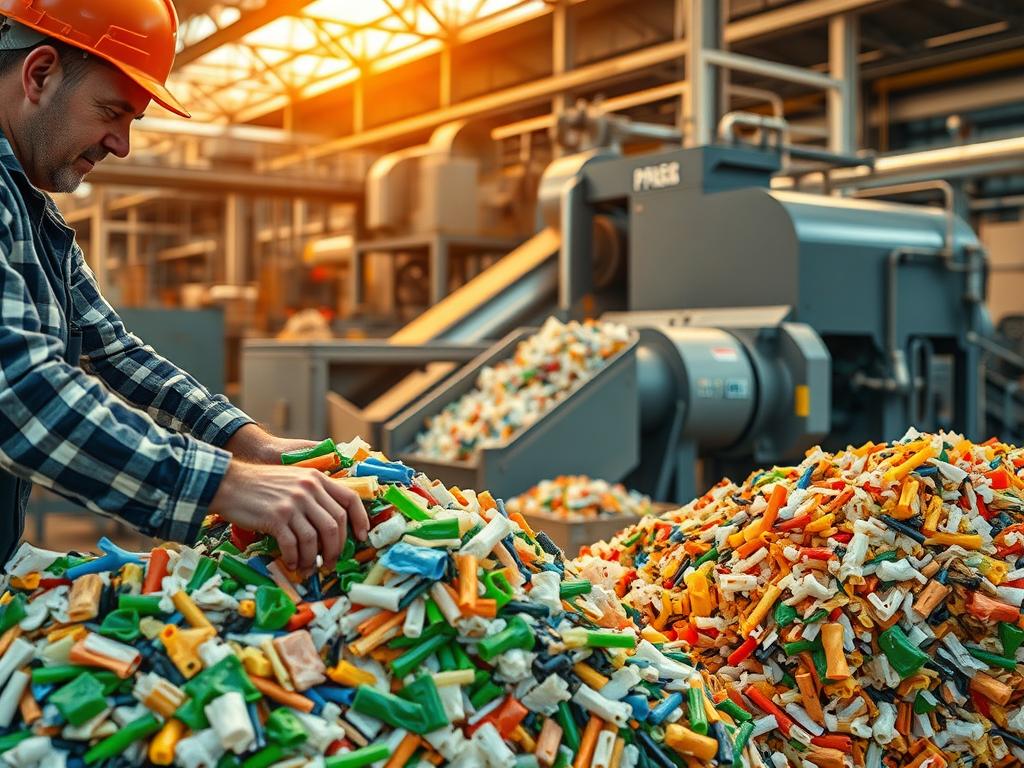Polyvinyl chloride (PVC) is a versatile plastic used in many industries worldwide. It’s the third most produced thermoplastic polymer globally, with over 20 million tons made annually. PVC consists of 57% sea salt and 43% petrochemical raw materials.
PVC recycling offers a sustainable approach to material management. This durable plastic can last 30-40 years and be recycled up to 7 times. These features make PVC an attractive option for industries seeking sustainable solutions.
The recyclable plastics market is evolving, with new PVC processing techniques emerging. Manufacturers are finding ways to reduce environmental impact while maintaining the material’s properties. PVC shows versatility in construction and medical applications.
Understanding PVC recyclability is vital for environmental sustainability. By exploring its composition and recycling potential, we can find new ways to manage plastics responsibly. This knowledge helps us conserve resources and protect our environment.
Understanding PVC: Composition and Properties
Polyvinyl chloride (PVC) is a remarkable synthetic polymer with unique characteristics. It’s invaluable across multiple industries. The PVC composition reveals a complex material that has transformed modern manufacturing and construction.
PVC’s chemical makeup is fascinating, with about 57% chlorine by weight. This distinctive composition contributes to its exceptional properties and versatility. PVC’s molecular structure allows for remarkable adaptability through various additives.
Chemical Structure Insights
PVC properties stem from its unique polymer chain. It can be modified to create materials ranging from rigid pipes to flexible medical devices. The polymer’s ability to incorporate different additives enables manufacturers to engineer specific characteristics.
Key Physical Characteristics
- High durability with potential product lifespan exceeding 50 years
- Resistance to chemical degradation
- Low fire spread potential (ignition temperature of 455°C)
- Excellent dimensional stability
Diverse Industrial Applications
PVC uses span numerous sectors, with about 50% dedicated to construction applications. From underground pipes to window frames, PVC shows remarkable versatility. Its unique properties enable engineering solutions across multiple domains.
PVC’s adaptability makes it a cornerstone material in modern industrial design.
PVC’s processability and tailoring capacity through additives make it a critical component in contemporary manufacturing. It offers solutions that balance performance, cost-effectiveness, and engineering flexibility.
The Environmental Impact of PVC
PVC environmental concerns have grown significantly in recent years. It’s the third most common plastic made globally, with a complex ecological profile. The lifecycle of PVC involves multiple environmental issues that challenge both manufacturers and environmentalists.
PVC production has substantial environmental effects. Greenhouse gas emissions from its manufacturing contribute greatly to global carbon footprints. In 2020, American PVC production emitted about 18 million metric tons of CO2.
- PVC production accounts for 4.5% of global greenhouse gas emissions
- Six percent of global coal electricity supports plastics production
- The global PVC market is projected to reach $56.1 billion within three years
PVC sustainability efforts have become crucial in addressing these environmental challenges. Recycling technologies offer promising solutions to these issues. Mechanical and chemical recycling methods allow PVC to be reused 6-7 times.
| Recycling Method | Energy Efficiency | Potential Applications |
|---|---|---|
| Mechanical Recycling | Lower energy consumption | Construction materials, packaging |
| Chemical Recycling | Higher energy requirements | Advanced material restoration |
Despite obstacles, innovative approaches continue to develop. These efforts address PVC environmental concerns and explore more sustainable production methods. Recycling strategies are also being improved to reduce PVC’s impact.
Can PVC Be Recycled?
Polyvinyl chloride (PVC) recycling is a complex issue. Over 20 million tonnes are produced worldwide annually. Recycling PVC requires sophisticated approaches to balance environmental concerns with practical solutions.
PVC recycling involves intricate processes addressing various waste management challenges. The material’s unique chemical composition makes traditional recycling methods insufficient for complete sustainability.
Types of PVC Waste
PVC waste falls into two main categories:
- Post-industrial waste: Clean, uniform materials from manufacturing processes
- Post-consumer waste: Mixed, contaminated materials from various sources
Recycling Capabilities and Limitations
PVC recycling methods include mechanical and feedstock approaches. Mechanical recycling suits industrial waste, while chemical processes work for consumer plastics. PVC can be recycled six or seven times before quality declines.
Processing Methods
Key PVC recycling techniques involve:
- Grinding and cleaning waste materials
- Thermal decomposition
- Chemical component separation
Challenges remain in PVC waste management. A staggering 83% of uPVC waste still ends up in landfills. Advanced technologies are needed to reduce environmental risks and maximise material reuse.
Conclusion
PVC recycling faces major hurdles, yet offers promising prospects. Currently, less than 0.25% of used PVC is recycled globally. The circular economy approach could revolutionise how we handle this common material.
Gasification and chemical recycling are emerging as vital solutions. Mechanical recycling allows PVC to be reprocessed up to eight times. This resilience hints at PVC’s potential to become more eco-friendly with better waste management.
The future of PVC recycling is bright. Eco-friendly alternatives and improved recycling methods are sparking change. Industries are embracing sustainable practices to reduce PVC’s environmental impact.
Everyone has a part to play in advancing PVC recycling. By backing responsible waste management and choosing sustainable products, we can make a difference. Together, we can create a more efficient and eco-conscious approach to PVC use.


